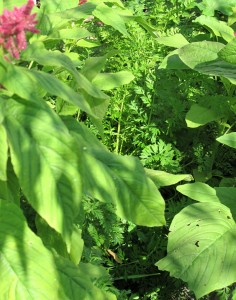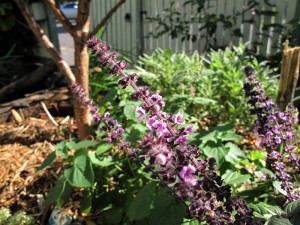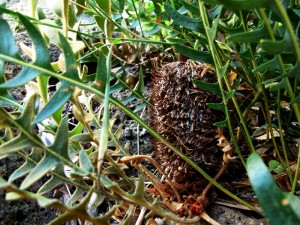Like very often we started from a tired garden, a mix of native shrubs and weedy plants. We have been implementing our design in stages over the last few years.
The first stage included the construction of 4 raised garden beds and the installation of a large water tank.

This raised garden bed is perfectly positioned to allow for the perfect amount of sunlight all year round. It also doubles as a climbing garden in summer to provide well needed shade to the bedroom windows right above it. Beans are planted in spring and they are grown along a permanent set of wires.
Integrating the old and the new as well the edible and the ornamental was very rewarding.

These hardy natives and perfume plants benefit from the moisture provided by the irrigation system of the raised garden bed in the background.
The raised garden beds provide a yield within weeks of being built.

The dozen square meters of raised garden beds we built are more then enough for the family. The beds are entirely dedicated to vegetables and greens. As you can see here edible weeds such as this amaranth are welcomed, embraced and mercilessly devoured!
The second phase included planting 7 fruit trees as well as diverting grey water and overflow from the tank to water the garden in a 100% passive way.
Invisible to the eyes are mulch basins and pipes delivering water deep in the ground, actively storing thousands and thousands of litres of water within the landscape. This type of watering makes for a very resilient and ecologically sound garden.

These two citrus and their companions have never received a drop of tap water since they have been planted. Exclusively watered from the tank’s overflow, a large mulch basin stores and slowly releases enough water for them for to go through the driest times.

A babacco, or cold climate papaya. Nowhere as sweet as its tropical cousins papaya and pawpaw… but still quite an amazing fruit!
Phase three saw a bit of vertical gardening take place, with a passion fruit vine taking hold of a timber fence, a few kiwi vines starting their ascend of a wire structure covering a brick wall and a generous patch of raspberries doing their part to green up a fence.
Phase three; countless companion plants, herbs, perennials and self seeding annuals were introduced around the fruit trees.

Each companion and useful plant is positioned so that it received the right amount of sun and water.
This allows for many layers of production: the canopy of the fruit trees, different size shrubs, ground covers, tubers…
Such a planting strategy is often referred to as “food forest”. In a case like this one, we might want to call it a micro food forest.

This Greek basil in bloom is not only a highlight in a fresh salad, it also confuses pests and attracts pollinators.
The final phase has seen a pond being built and used to gather rainwater.
Its is always amazing to see how much a few hundred litres of water can change the feel of a garden. Ponds not only attract birds and wildlife, they seem to captivate people too.

This pond is filled up from a roof… and is host to more living creature then one could count in a lifetime.







